Two blocks with masses m1=0.2 kg and m2=0.3 kghang one under other as shown in figure. Find the tensions in the strings (massless) in the following situations :
(g=10m/s2)
they accelerate upward at 2m/s2
The correct Answer is:6 N, 3.6 N
To find the tensions in the strings when two blocks of masses m1=0.2kg and m2=0.3kg are accelerating upward at 2m/s2, we can follow these steps:
Step 1: Identify the forces acting on the blocks
- For block m1:
- The tension T1 acts upward.
- The weight m1g acts downward.
- For block m2:
- The tension T2 acts upward.
- The weight m2g acts downward.
Step 2: Write the equations of motion
- For block m1:
T1−m1g=m1a
- For block m2:
T2−m2g=m2a
Step 3: Substitute the values
Given:
- g=10m/s2
- a=2m/s2
- m1=0.2kg
- m2=0.3kg
Substituting these values into the equations:
1. For block m1:
T1−(0.2)(10)=(0.2)(2)
T1−2=0.4
T1=2+0.4=2.4N
2. For block m2:
T2−(0.3)(10)=(0.3)(2)
T2−3=0.6
T2=3+0.6=3.6N
Step 4: Final results
The tensions in the strings are:
- T1=2.4N
- T2=3.6N
Summary
- Tension in the string above block m1 (T1): 2.4N
- Tension in the string above block m2 (T2): 3.6N
---
- For block m1:
- The tension T1 acts upward.
- The weight m1g acts downward.
- For block m2:
- The tension T2 acts upward.
- The weight m2g acts downward.
- For block m1:
T1−m1g=m1a
- For block m2:
T2−m2g=m2a
Given:
- g=10m/s2
- a=2m/s2
- m1=0.2kg
- m2=0.3kg
T1−(0.2)(10)=(0.2)(2)
T1−2=0.4
T1=2+0.4=2.4N
T2−(0.3)(10)=(0.3)(2)
T2−3=0.6
T2=3+0.6=3.6N
The tensions in the strings are:
- T1=2.4N
- T2=3.6N
- Tension in the string above block m1 (T1): 2.4N
- Tension in the string above block m2 (T2): 3.6N
Topper's Solved these Questions
- NEWTON'S LAWS OF MOTION & FRICTION Book:MOTIONChapter:NEWTON'S LAWS OF MOTION & FRICTION Exercise:Questions For Practice
Explore 25 Videos
- NEWTON'S LAWS OF MOTION & FRICTION Book:MOTIONChapter:NEWTON'S LAWS OF MOTION & FRICTION Exercise:Exercise - 1 (SECTION-A:- String Constrained, Wedge Constrained, Newtons Law theory Question, Equillibrium Questions (Normal and Tension), Problems with Acceleration (F=ma), Wedge problems)
Explore 27 Videos
- NEWTON'S LAWS OF MOTION & FRICTION Book:MOTIONChapter:NEWTON'S LAWS OF MOTION & FRICTION Exercise:Exercise - 3 Section-B
Explore 12 Videos
- MODERN PHYSICS -1Book:MOTIONChapter:MODERN PHYSICS -1Exercise:EXERCISE-4 ( LEVEL- II)
Explore 39 Videos
- NLM & FRICTIONBook:MOTIONChapter:NLM & FRICTIONExercise:EXERCISE-4 ( LEVEL-II)
Explore 15 Videos
Similar Questions
Two blocks with masses m1=0.2 kg and m2=0.3 kg hang one under other as shown in figure. Find the tensions in the strings (massless) in the following situations :
(g=10m/s2)
they accelerate downward at 2m/s2
View SolutionTwo blocks with masses m1=0.2 kg and m2=0.3 kg hang one under other as shown in figure. Find the tensions in the strings (massless) in the following situations :
(g=10m/s2)
they move upward at 5 m/s
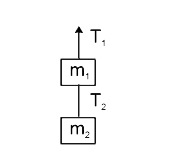
View Solution
Knowledge Check
Two block of masses m1 and m2 are connected as shown in the figure. The acceleration of the block m2 is:
 Am2gm1+m2Bm1gm1+m2C4m2g−m1gm1+m2Dm2gm1+4m2
Am2gm1+m2Bm1gm1+m2C4m2g−m1gm1+m2Dm2gm1+4m2
Two blocks with masses m1=0.2 kg and m2=0.3 kg hang one under other as shown in figure. Find the tensions in the strings (massless) in the following situations :
(g=10m/s2)
the blocks are at rest
View SolutionTwo blocks with masses m1=0.2 kg and m2=0.3 kg hang one under other as shown in figure. Find the tensions in the strings (massless) in the following situations :
(g=10m/s2)
if maximum allowable tension is 10 N. What is maximum possible upward acceleration ?
View SolutionA 'block' of mass 10 kg is suspended with string as shown in figure. Find tension in the string. (g=10m/s2)
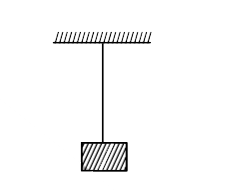
View SolutionWhat will be the reading of spring balance in the figure shown in following situations ( g=10m/s2 )
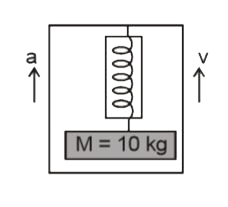
a=−2m/s2,v=0
View SolutionWhat will be the reading of spring balance in the figure shown in following situations ( g=10m/s2 )
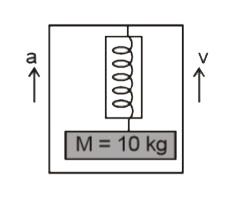
a=2m/s2,v=0
View SolutionWhat will be the reading of spring balance in the figure shown in following situations ( g=10m/s2 )
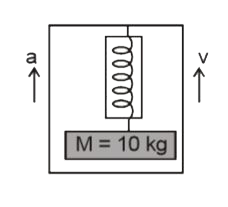
a=0, v = −2m/s
View SolutionWhat will be the reading of spring balance in the figure shown in following situations ( g=10m/s2 )
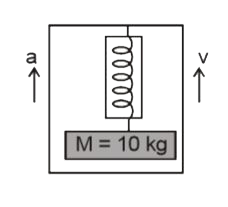
a=0,2m/s
View Solution

